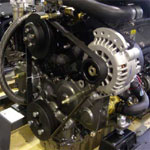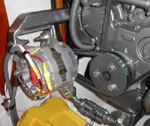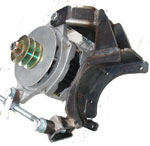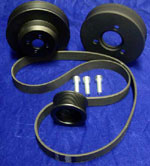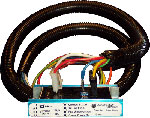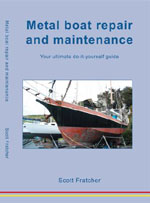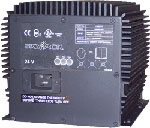Marine Security
Boat and trailer security
In this article we talk about easy methods to prevent boat and trailer
theft.
The idea of security is to implement simple techniques that make your
marine possession “too difficult” or “too high a risk”
to be stolen. Some might say you only have to provide enough security
so a thief chooses the next boat.
This may not be that far from the truth. A quick scan of ten trailers
at a local boat ramp showed only one wheel lock in use and three of
ten boat trailers had no security at all.
Lets look as some deterrents to theft-
* An alarm system,
* An upgraded locking system,
* Marking the boat for easy identification.
* Methods of immobilizing boat,
Reducing motivation includes-
* Lowering the amount of perceived gain from theft
* Reducing the perceived value of the stolen items-IE paint and permanent
engravings
#1 Rule-Keep valuables out of sight
Keeping valuables out of sight is listed as the number one theft deterrent
on every police and insurance checklist. For the owner of a boat this
is not really an option. The crew may be living or vacationing inside
the boat so the thief may imagine there will be something of value inside
even if every cupboard is closed and the table is clear.
Lets look at some other deterrents.
Trailer boats
Trailers and boats are particularly easy to steal as they are designed
to be drug behind another vehicle. Some common methods of theft prevention
are-
Wheel Locks
Wheel locks are a simple device that immobilizes the wheels of a vehicle
or trailer preventing movement. Wheel locks are often used by police
to immobilized vehicles and have a sound reputation as a theft deterrent.
Wheel locks come in a variety of qualities. In the most basic form
they simply clamp around the wheel, but leave the lug nuts and bearing
exposed. For the professional thief this is slightly better than no
wheel lock. Once the thief has a collection of trailers it’s only
a matter of carrying a spare tire in the tow vehicle. By changing the
tire protected by the wheel lock the trailer is quickly rolling along
behind the new tow vehicle.
Better is a wheel lock that covers the lug-nuts and wheel bearing.
The SAS wheel lock made in New Zealand is a prime example of the higher
level of protection that covers the wheel bearing and a lug nut. This
is good as it prevents the thief from easily changing the tire.
Vulnerable ball hitch
Most ball hitches arrive with some type of locking mechanism. At first
glance this may seem sufficient, but is it really?
The lock on the tongue of the trailer must be designed to prevent a
pair of bolt cutters from reaching the lock shank. An inexpensive pair
of bolt cutters will slice the shank of almost any lock quickly and
quietly. For this reason most trailer locks now employ the single shank
style of lock, thus preventing bolt cutter access.
Hacksaw the lock
The single shank is still vulnerable to a hacksaw. A short length of
pipe placed around the lock shank prevents the hacksaw from getting
a bite. Make sure the pipe completely fills the shank width so a hacksaw
blade can’t be slid down the side of the lock.
Ball hitch bolts
The bolts that secure the ball hitch to the trailer are the next easily
removed piece of the security puzzle. Once a thief is in the trailer
theft business keeping a supply of interchangeable trailer parts is
simple.
The tongue nuts can be made more secured with red lock tight or tack
welded to prevent simple disconnection and re-bolting to another trailer.
Leaving extra thread showing on the securing bolts during installation
can also increase the difficulty of removing the hitch.
Warning
Recently there has recently had a rash of trailer thefts from boat
launch areas. When the unfortunate fisherman returns to the dock to
find his trailer nicked he often heads off in search of another trailer.
During his absence the stolen trailer returns to load the victims boat
(fitting perfectly) making a clean get a way with a double theft, boat
and trailer.
One method to help prevent theft like the above scenario is to leave
the trailer locked to the vehicle. Back the trailer into an obstacle
like a curb or tree so there is less room to maneuver the trailer away
from the vehicle.
Trailer load locks
Once the trailer itself is secured now we turn out attention to the
load carried on the trailer. Jet skies are a prime theft target. Two
or three men can easily lift a jet ski from the trailer and transfer
it to another location. For this reason the Jet ski or load itself can
be cable locked to the trailer.
Paint
Most law enforcement agencies recommend painting the trailer and boat
with a distinctive paint job. This can be difficult for a boat trailer,
but the plate number or phone number can be welded directly into a support
beam. It’s a good idea for this number to be plainly visible to
help reduce motivation.
A detailed paint job can be expensive. Some prefer to simply paint
stripes while others use high quality printed stickers. This paint scheme
can increase the value of the trailer and boat while deterring theft.
Location
Picking the location to park your boat is an early choice that greatly
effects the risk of theft.
Phil McSweeney of “Safe and Secure” (SAS) wheel locks tells
us the highest theft risk is light industrial areas during the day.
The amount of noise and work normally taking place in such areas can
mask a theft, yet this is commonly thought of as a safe parking area.
Parking on the street in front of your house is better, but it’s
easy for thieves to notice when the house is vacant. Parking by the
side of the house, or between houses is better yet, and a second stored
vehicle blocking the departure path of the trailer is an added deterrent.
Best is storing a boat in a well lit, camera-monitored area with one
road in and out. Signs warning of passive recording of the number plate
of every vehicle can go a long way in deterring the initial theft or
locating a stolen vehicle.
Marina Security
Boats stored in the water are reliant on the marina security system.
When deciding on a marine consider-
* Are security cameras set up?
* Are they monitored?
* Have there been thefts recently?
* Was the security upgraded since the thefts?
It’s common for a company to purchase all the correct security
devices only to ignore the system expecting to review the tapes if a
theft happened to occur.
Marinas like Gulf Harbor, north of Auckland, have an excellent protection
record, while boats on moorings in the adjacent Wade River have reported
a string of violations. The difference can be attributed to the Gulf
Harbor single road access and monitored security while the Wade River
has multiple road access points and little security.
Window Markings
Etching the plate number into the window of a boat can help deter thieves.
It should be noted the vehicle identification number should not be used
as this number can be matched to the boat key for easy duplication.
A window marking warning of an alarm can help, but the warning should
not include the alarm brand name as this gives the thief a clue to the
type of alarm he has to disable.
Photos
Take photos of your boat from all angles. Take photos of the serial
number, number plate, and engine identification tags. Take another set
of photos of each piece of equipment’s identification plate (IE
radios, auto pilots, etc) so if the equipment is separated from the
boat you have a method of easy identification. By photographing you
don’t have to spend time writing long numbers as the serial numbers
are stored in a single photo set.
Keep boat photos (and document photos) in a safe place, preferably
stored on the net (IE emailed to yourself) so you can find them quickly
if needed or away from your home computer.
GPS Tracking
GPS tracking is quickly becoming the prime method of locating a stolen
boat. The GPS tracker runs continuously monitoring a pre-determined
guard ring. If the boat leaves the trailer park or marina the alarm
sounds, and sends a text to a cell phone. The owner can view a web page
that shows the vehicle’s progress. It’s a simple matter
of calling the police with a description and current location of the
vehicle.
GPS tracking can be purchased with two reporting options, satellite,
or the less expensive cell phone reporting. This is important as if
a vehicle is driven into an area without cell coverage, or a yacht is
taken offshore the locating beacon will stop reporting.
Some tracking systems, such as pivotel.com.au report worldwide through
the Global Star satellite system while Geosystems.co.nz and Verifind.co.nz
are local NZ suppliers that report through the cell phone network.
Equipment costs start around seven hundred dollars. Short-term rentals
units are available.
Outboard security
Yachts from the Caribbean have found themselves in a one-upmanship
challenge with local thieves. In an attempt to prevent outboard theft,
yachts began using a standard clamp lock on the securing bolts that
hold the outboard to the tender transom. Thieves quickly learned to
disable the commercial locking devices with a simple crescent wrench.
Specialty shops began making an upgraded stainless version of the outboard
clamp. Thieves began using a hand sledge and a large punch made from
rebar to break the outboard mounting clamp bolts. Stainless clamp bolts
were built and distributed throughout the fleet.
The thieves then began cutting the transom out of the tender with battery
operated reciprocal saws to remove the outboard. Yachts started adding
a stainless plate on each side of the transom in an attempt to outlast
the battery packs.
Yacht crew’s took further precautions by hoisting and locking
the tender into davits, but thieves cut the locks. Special davits were
designed that clamped the complete tender or outboard. Thieves began
using high tech pipe cutters to slice through stainless davits or rails
that secured the tender. The yachts began building davits and rails
with an inside tube that a pipe cutter couldn't’t reach.
Safes
Traveling by boat means we often carry many important documents with
us. Passports, bank cards, ownership paperwork, even the possibility
of a document that may allow the thief further access to our lives might
inadvertently be kept in the boat. To help secure these valuable papers
many install a safe or a strong box.
A safe should be well hidden away from public view and well secured
to the hull. The idea is to install the strong box so it takes time
to find, and makes noise to remove. Thick bolts that can’t be
accessed from the backside are a good start.
One of the most common mistakes in safe installation is talking about
it. This is a real case of “loose lips sink ships.” Once
the a potential thief knows about the safe their motivation level rises
to open the “surprise.”
Electronic safe prices start as low as $75 dollars and a better version
with mechanical tumblers can cost upward of $400.
Insurance
Once you have taken all the anti-theft precautions you can simply relax
and enjoy the day. If you return to a stolen trailer or boat you will
have an inconvenience, but at least you’ll be financially covered.
Or will you?
Phil McSweeney of SAS reports many insurance companies require that
some forum of extra protection had been installed and used on the stolen
trailer. For this reason Phil recommends checking the fine print of
your policy and taking a photo of the anti theft devices in use. Keep
these photos stored on your hard drive and emailed to yourself so if
the unfortunate were to occur you have simple proof the secondary locking
device was used. This can reduce the chances of a delay of payment.
Post theft
In the unlikely event your boat or trailer is stolen you should take
the following steps-
* Call the local police to file a report.
* Notify your insurance
* Post photos of the stolen items on http://www.stolenz.co.nz
Don’t buy a stolen boat
One way to reduce the chances of your boat being stolen is to reject
the purchase of a stolen boat. The NZ Police website recommends the
following to prevent unknowingly purchasing a stolen vessel-
* Expect to pay a fair price. An unreasonably low boat price should
raise concerns.
* Be sure to inspect the serial number of the boat and outboard motor.
* Look for signs of recent ownership changes.
* Trace the ownership history.
* Record the seller’s details.
* Take a photo of the seller.
* Contact the local police with the plate number to check if the trailer
is stolen.
See- http://www.police.govt.nz/ for more information.
Ten cent solutions
Ten cent solutions are mostly a bluff in an attempt to prevent theft.
Still for the DIY here are some simple techniques that have proved themselves
in the field.
A common “ten-cent” alarm system is to connect a battery
to a siren. A clothespin with contacts on the openings acts as a trigger
switch. The clothespin is held open by a bit of plastic sheet. If the
skiff is moved the plastic pulls free, and the clothespin snaps shut
sounding the alarm.
More simple and inexpensive methods of reducing theft include-
* A red LED flasher mounted on the trailer can present an image of
an alarm system.
* Remove the coil lead, or other important part when the boat is left
unattended.
* Engrave your number plate on the engine, parts, and windows in a high
profile location. This will lower the motivation, as the vessel parts
will be less valuable.
* Engrave another set of numbers in a hard to find location so if you
ever stumble across your engine you have proof the outboard was once
yours.
Future
On the horizon are a series of new technologies to help prevent theft.
The advent of computerized engine control systems will soon lessen
the value of stolen vehicle parts. Without the manufacturer interface
the stolen parts will not function outside the original vehicle thus
reducing the “chop shop” value.
GPS tracking and satellite monitoring means the main engine can be
shut down by a single push of a button from a remote location. Imagine
the surprise of a thief when motoring along and the engine suddenly
shuts down. A voice from a manufacturer representative asks why the
boat is underway.
|

